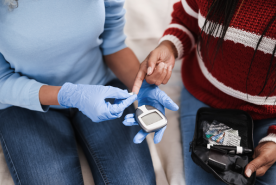What is distal tubular renal acidosis (dRTA)?
dRTA is a rare but serious type of kidney disease that can be inherited (primary dRTA) or be caused by another disorder or medication (secondary dRTA). Primary dRTA is also known as primary type 1 RTA. Renal refers to the kidney, distal tubular refers to a specific part of the kidney and acidosis means there is too much acid buildup in the blood.
The kidneys have many important jobs. One of them is to maintain a balance between acid and base (opposite of acid) by removing and filtering acids from the blood and through the urine. dRTA happens when the kidneys can’t effectively remove the buildup of circulating acids in the blood. The buildup of acids in the blood causes an imbalance known as “acidosis” or “metabolic acidosis”.
Metabolic acidosis is a serious health problem and requires prompt medical attention. dRTA can also cause kidney stones, brittle bones, hearing loss, digestive problems, and other medical problems. Not all people living with dRTA will experience the same health problems. dRTA is part of a class of disorders known as renal tubular acidoses (or renal tubular disease). There are four (4) types of renal tubular acidoses, with primary dRTA identified as the most common type.
dRTA
Sign up for a deep dive into dRTA
Learn about dRTA, receive additional resources, and learn so much more.
What causes dRTA
Primary dRTA has a genetic (inherited) origin, which means it is passed along from parent(s) to child. dRTA can also be acquired, which means it can be caused by another disease or medication, as is the case with secondary dRTA. There are four (4) types of renal tubular acidosis, with primary dRTA identified as the most common inherited type.
Inherited primary dRTA has been linked with changes, or mutations, in several genes. Names of these genes include SLC4A1, ATP6V0A4, or ATP6V1B1. These genes are responsible for managing the level of acid or base in the body. When these genes have a change or mutation, it can lead to inherited primary dRTA. These changed genes can be passed down from parent(s) to child. Inherited forms of dRTA include an autosomal dominant (AD) dRTA, and autosomal recessive (AR) dRTA.
- AD dRTA: Changes in the SLC4A1 gene have been linked with autosomal dominant (AD) dRTA. AD inheritance means that only a single copy of the disease-causing gene is needed for the child to inherit the disease. With each pregnancy, there is a 50% chance the disease-causing gene will be passed from the parent to the child, regardless of the sex of the child. Compared to AR dRTA, people with AD dRTA typically have milder acidosis and present later in life, often in adolescence or adulthood. However, people with AD dRTA can still have health problems, such as kidney stones and bone disorders.
- AR dRTA: In the autosomal recessive (AR) form of dRTA, both the mother and father are carriers of one of the disease-causing genes. With each pregnancy there is a 25% chance the child will inherit the disorder, a 50% chance the child will be a carrier like the parent, and a 25% chance the child will be neither a carrier nor affected with dRTA. Changes in the ATP6V0A4 and ATP6V1B1 genes have been linked with AR dRTA. AR dRTA is most likely to be seen in infancy.
Secondary (or acquired) dRTA can be caused by another disease, mainly autoimmune disorders such as Sjögren's syndrome, systemic lupus erythematosus (SLE), or rheumatoid arthritis. Secondary dRTA can also be caused by certain medications, such as amphotericin B (an antifungal), lithium (a psychiatric medication), and certain antibiotics (pentamidine). Nonsteroidal anti-inflammatory drugs (NSAIDs), including ibuprofen and naproxen, rarely cause dRTA but their overuse can be harmful to the kidneys. Based on the timing of the injury to the kidney, secondary, acquired dRTA can be diagnosed at any age.
Like other rare disorders, it can be difficult to know exactly how many people have dRTA. To date, it is estimated that about 20,000 patients in the United States suffer from primary and secondary dRTA. Men and women are affected equally.
What happens in people living with dRTA?
There are two kidneys, each about the size of a fist, located on either side of the spine at the lowest level of the rib cage. Each kidney contains up to a million functioning units called nephrons. A nephron consists of a filtering unit of tiny blood vessels called a glomerulus attached to a tubule.
In people living with dRTA, a part of the tubule called the distal tubule does not secrete enough acid from the blood into the urine. As a result, acid production by the body exceeds removal and blood becomes too acidic.
The imbalance of too much acid in the blood is known as “acidosis” or “metabolic acidosis”. It can lead to many health problems and can vary in severity. In order to lessen (or buffer) the excess of serum protons (from circulating acids in the blood), the body can mobilize calcium and buffers such as bicarbonate and phosphate out of the bone. However, this process involves calcium leaching out of the bones. The loss of calcium from the bones can lead to thinning (osteoporosis) or bending (rickets) of the bones, kidney stones, and calcium deposits (nephrocalcinosis) in the kidneys. In addition, potassium levels in the blood can fall causing fatigue, muscle pain and cramps, and in the most severe cases, temporary paralysis and heart rhythm changes.
Check out our online communities to connect, learn more and hear from others going through similar experiences.
What are the signs and symptoms of dRTA?
Primary dRTA can cause a wide range of signs and symptoms. Symptoms can begin in infants or as late as adulthood. Not everyone will experience the same symptoms as they can vary depending on such factors related to the specific gene change, level of acidosis (acid in the blood), age of the individual, and even how advanced the disease is. Secondary dRTA usually happens later in life.
Severe complications can occur in infants with primary dRTA. Early signs and symptoms in babies include nausea and vomiting, dehydration, extreme tiredness, feeding issues and problems with weight gain (also known as failure to thrive). These are symptoms consistent with metabolic acidosis and it’s important to seek medical attention right away for a baby experiencing these symptoms.
Because calcium can be leached from the bones in people living with dRTA, the disease can lead to mineral imbalances and bone disorders. The imbalance of deficient calcium in bones or excess calcium in the blood and urine can cause a softening and weakening of bones. Children can develop rickets, a condition in which the bones actually bend as they are too soft and do not harden or calcify as normal. Children may also experience stunting of growth and may not reach their full adult height potential. Osteomalacia (a softening of bones in adults) and osteopenia (weakening and brittle bones in adults) are consequences that can lead to increased risk of fracture. Bone disorders are not as common in the dominant (AD dRTA) pattern of inheritance.
Not only can calcium affect the bones, but high levels of calcium in the blood and urine can lead to calcium deposits in the kidneys, a condition known as nephrocalcinosis, which is related to, but not the same as kidney stones.
Mineral imbalances caused by dRTA can also lead to the formation of kidney stones. If kidney stones keep coming back after they are removed (recurrent) it can increase the risk of chronic kidney disease (CKD) and impact the filtering ability of your kidneys. Although considered uncommon, people with dRTA may be at higher risk of developing kidney failure, which would ultimately require dialysis or a kidney transplant.
dRTA can cause low levels of potassium in the blood— a serious condition known as hypokalemia. Potassium is a key electrolyte that supports nerve and muscle health. Hypokalemia causes severe muscle weakness, breathing difficulties and abnormal heart rhythm (cardiac arrhythmias). In extreme cases of hypokalemia, severe cardiac arrhythmias, paralysis and even death can occur.
Sensorineural hearing loss is linked with primary dRTA and can lead to difficulty with hearing caused by changes in the inner ear. This can lead to deafness in some people, but not all. Changes in certain genes have been linked with hearing loss. For example, changes in SLC4A1 gene have not been linked with hearing loss. However, changes in the ATP6V1B1 gene have been linked with hearing loss.
Patients living with primary dRTA can also experience serious digestive (or gastrointestinal) disorders. The most commonly reported digestive disorders are anorexia, vomiting, diarrhea and constipation. These symptoms are usually due to metabolic acidosis, but low potassium can also causes digestive problems.
The following list describes possible signs and symptoms of dRTA. It is important to be aware of these symptoms and to contact a healthcare professional if you or a loved one experience these signs or symptoms, or if you notice a sudden change in symptoms.
- Confusion or decreased alertness
- Fatigue
- Muscle weakness
- Breathing difficulties
- Increased heart rate or irregular heartbeat
- Muscle cramps and pain
- Severe pain in the back, sides or abdomen (known as flank pain) as this may indicate a kidney stone
- Bone pain
- Less urine output
- Hearing loss
Symptoms related to low potassium (hypokalemia) - irregular heartbeat, breathing difficulties, severe weakness and fatigue - may require immediate medical attention. Symptoms such as severe weakness, headache, confusion, and increased heart rate can also be caused by severe acidosis. These symptoms also require immediate medical attention.
How is dRTA diagnosed?
dRTA is diagnosed using a combination of tests, including a physical exam looking for signs and symptoms of the disease, along with blood and urine tests. If primary dRTA runs in your family, your healthcare team may take a detailed family history to help identify at-risk family members. Genetic testing may be offered to help confirm the diagnosis.
Your healthcare team may check for other diseases that can cause secondary dRTA, such as Sjögren's syndrome or systemic lupus erythematosus (SLE). Your medications will be reviewed for drugs that can possibly cause or worsen dRTA. This list should include all prescription medications, over-the-counter medications and herbal supplements you are taking.
Laboratory tests and a urinalysis are routine tests that analyze your blood and urine. Initial blood work for diagnosing dRTA involves measuring electrolytes within the blood, such as sodium, potassium and chloride. Tests can also measure the blood pH to see if it is too acidic. Blood levels of potassium and carbon dioxide (types of acid) and bicarbonate (a type of base) are measured to help complete the pieces of the puzzle for your healthcare team to make a diagnosis.
Your urine will also be measured for electrolytes. The pH of the urine will be checked to see there is a defect in acid secretion. The urine will also be analyzed for protein, bacteria and blood cells to help with a diagnosis of dRTA and to rule out other causes of the disease.
Genetic testing to look for changes in certain genes, such as ATP6V0A4, SLC4A1 or others, can also be ordered by your healthcare team to help confirm a diagnosis for primary dRTA.
Additionally, imaging tests, such as X-rays, ultrasound and a CT scan can be used to help see the severity of the disease, check for kidney stones, and check for calcium deposits in the kidneys (nephrocalcinosis).
A nephrologist, a doctor who specializes in disorders of the kidney, can help make the diagnosis of dRTA.

















